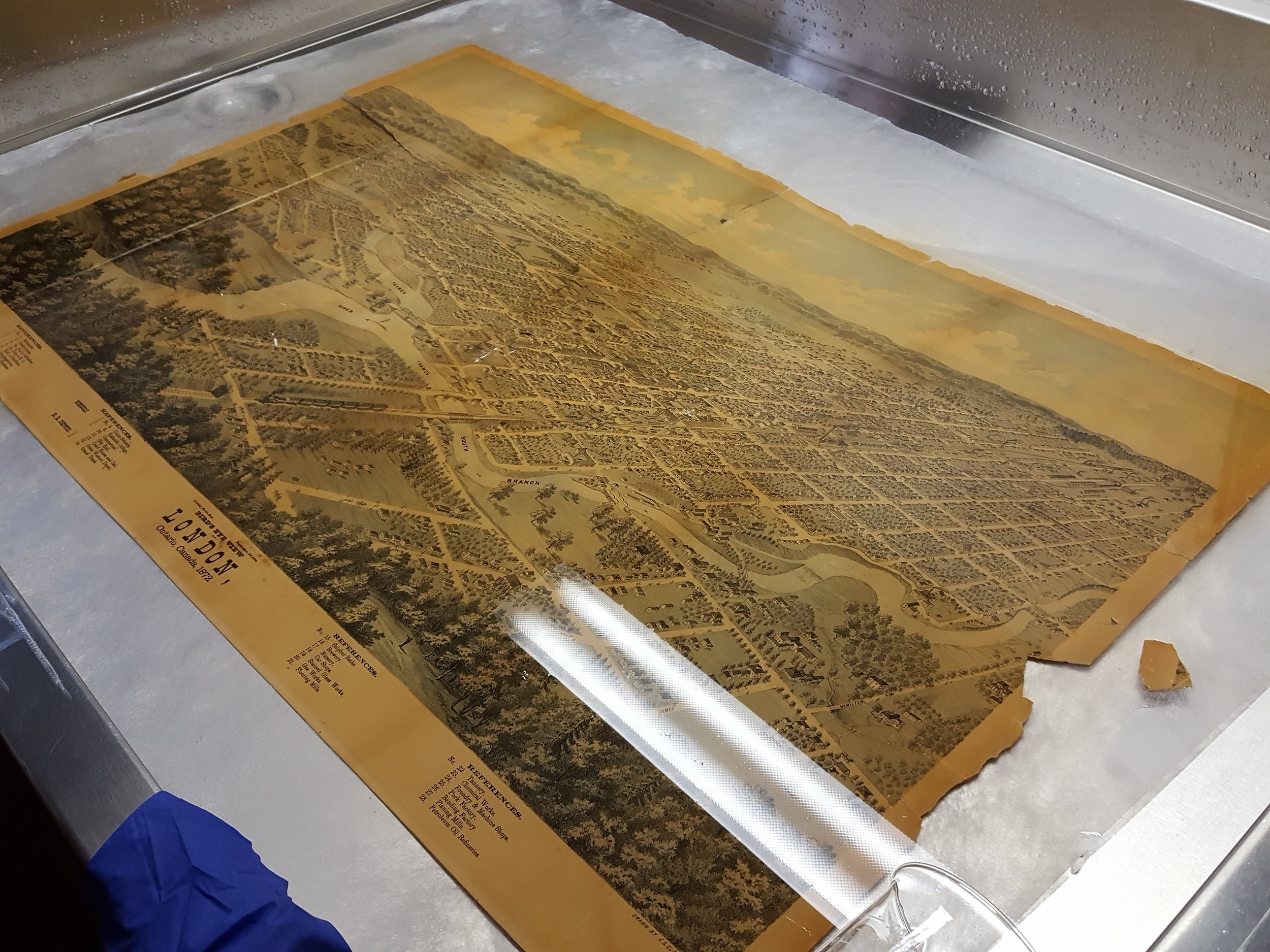Bird's Eye View of London, Ontario, Canada, 1872, before conservation treatment.
Book and Paper Conservation Services recently had the privilege of restoring this wonderful early Bird's Eye View map of London, Ontario, Canada. The detailed colour lithograph print, dated 1872, resides in the collection of Western University Archives, which holds extensive records of London's history.
History
The map is an illustrated vision of the city from a bird's eye perspective, a common theme in the late 19th century. It was drawn by the artist E. S. Glover, and produced by Strobridge Lithographing Company, in Cincinnati, OH. It would have been distributed in London and purchased by prominent local citizens at the time for display in homes and businesses.
Detail of the 1872 map showing streets of London, Ontario, and the Military Garrison in what is now Victoria Park.
The map illustrates significant buildings in the city as of 1872, such as the Covent Garden Market, Labatt Brewery, and the military garrison, situated on land which is now Victoria Park. The locations are numbered in a key in the bottom margin. The map is extremely interesting as a historic document because it depicts a number of streets and locations which no longer exist or have since been renamed.
When it arrived at our studio, the map suffered from a variety of condition issues. After examination and consultation with University Archivist Robin Keirstead at Western's Archives and Research Collections Centre, an extensive treatment protocol was determined. During the course of conservation treatment, the print underwent almost every process in a paper conservator's repertoire; it was an extremely satisfying project for our studio.
Condition
The map was produced by a lithographic printing process on machine-made wood pulp paper, a typical paper but prone to discolouration over time. Sometime in its life, it had been mounted to a black pulp board backer, a very acidic material which had further contributed to the overall yellowing and brittleness of the paper. It also exhibited pronounced discolouration in vertical bands across the image, as well as extensive tears and breaks in the paper and minor losses around the perimeter.
Tears and losses along the border of the print.
Creases and breaks distorting the surface.
In short, it was in urgent need of conservation treatment to keep it from deteriorating further, and to restore its original detail and vibrancy.
Conservation included surface cleaning to remove dirt and grime.
conservation treatment
The conservation treatment to address these damages included several stages. First, the print was surface cleaned to remove loose dirt and grime, and then the acidic backing was painstakingly removed with a scalpel and metal spatula, working from the verso to avoid any accidental damage to the print.
Next, the print was washed and light bleached to brighten the paper tone. The yellow discolouration products were removed from the paper in this process, returning the image closer to its original colouring and removing the distracting bands of stain from the print. It was also deacidified to halt further deterioration of the cellulose.
The Bird's Eye View of London is washed and deacidified to remove discolouration.
Once washed, the lithograph was lined onto a new, stable backing of Japanese paper, to provide support and repair the breaks and losses. This backing will not cause discolouration the way the old board did, and will help the print remain stable while also being slightly flexible.
Wash water becomes progressively less yellow as the print is cleaned. Behind, the washed and lined lithograph is visible brighter.
The Bird's Eye View of London, after washing and lining on a stable Japanese paper backing.
The final step in the conservation treatment was to inpaint losses to the printed image where cracks and breaks had disturbed the surface. Using watercolours and a delicate brush, the image was restored.
Inpainting to restore losses in the printed surface.
The restoration of this beautiful historic artifact was extremely successful, and the satisfying results can be seen below. The paper tone has been brightened, allowing the image to be viewed without distraction; the damages have been repaired and print is supported and stabilized with a new backing. It has been returned to the Archives where it will be stored and preserved in ideal conditions, and can be accessed by future researchers and interested Londoners for years to come.
Bird's Eye View of London, Ontario, Canada, 1872, before and after conservation treatment.
Art conservation is an extremely satisfying occupation, and Book and Paper Conservation Services was very pleased to have contributed to the preservation of this important artifact. If you have historic or archival materials or antique prints that you are interested in having restored, don't hesitate to get in touch with our studio. There is no charge for a consultation, and we are always happy to discuss conservation options with you.










